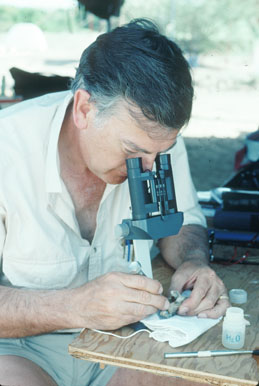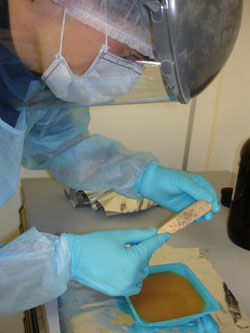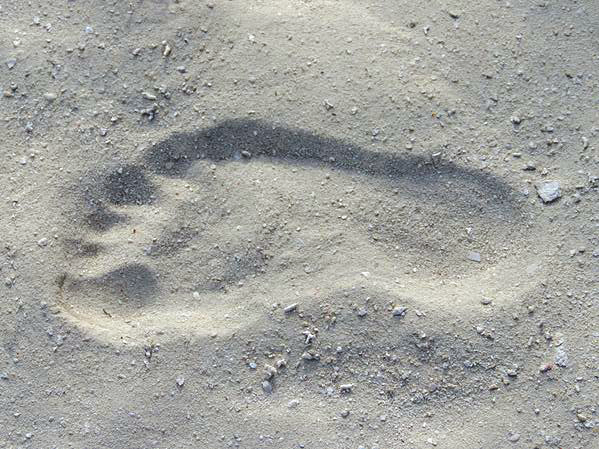
To the Laboratory!
 When we think of fossils and artifacts, we might think of what we see when we visit museums. However, before fossils are put on display, they are sent to a special place called a laboratory. Many laboratories, or labs, are at universities and museums all over the world. The labs are filled with special equipment.One of the first things that scientists want to know about fossils and artifacts is their age.
When we think of fossils and artifacts, we might think of what we see when we visit museums. However, before fossils are put on display, they are sent to a special place called a laboratory. Many laboratories, or labs, are at universities and museums all over the world. The labs are filled with special equipment.One of the first things that scientists want to know about fossils and artifacts is their age.
Scientists and technicians trained in various lab techniques run the labs, and they will analyze samples (such as bone or rock) to record its basic information. So when a fossil or tool arrives at the lab, what happens to it? Well, first, it might be tested to figure out how old it is.
The dating game
If you say you "dated a fossil," that doesn't mean you took it out to see a movie. Determining the age of an object is called "dating" it. We do this by looking at specific elements of the object. Not all dating techniques are the same, and they are often limited in the range of dates they can detect. This means that scientists have to choose the right dating method for a specific material or they won’t get an accurate result.
Dating methods can be split into two broad types: absolute and relative dating. Absolute dating methods provide an actual date for the fossil. Relative dating only determines if a fossil is older or younger than another fossil. It does not provide an actual age for the fossil.

One group of absolute dating methods that is vital to the study of human evolution is radiometric dating. Radiometric dating looks at the isotopes of specific elements (like carbon or argon) to tell you the age of an object. Not all radiometric dating methods are the same, and they often are limited in the range of dates they can detect. This means that scientists have to choose the right dating method for a material or they won’t get an accurate age.
One kind of absolute dating is radiocarbon dating. Radiocarbon dating measures the amount of carbon isotopes in a material and can date an object up to about 60,000 years ago. This is great for more recent things like preserved plant material or bone but wouldn’t work on a fossil that is three million years old.
Some other radiometric dating methods can date items that are from 700,000 to 50 billion years old. So they are perfect for analyzing three-million-year-old rock layers that contain volcanic glass. Once you find the age of the rock layer a fossil was found in you can infer the age of the fossil itself.
Let’s try an example: A fossilized femur (leg bone), other remains, and soil samples have just been flown in from Israel and are arriving at the lab in a few minutes. Based on the other fossils found at the site, you guess that the femur is younger than 30,000 years. What dating technique should you start with to figure out its age?
Based on what the excavation team found, you would try radiocarbon dating of the soil. Then you may try a second method as well just to make sure you got a correct date. Scientists will use different ways to date a material. This allows them to get the most accurate age estimate.
Dating and genes
 DNA is found in cells in the body, like blood and bone cells. Because every living thing has its own DNA sequence, scientists can use DNA to learn about an individual. Under the right conditions, DNA can be preserved for several thousand years after an organism dies. A geneticist can pull the DNA out of bones and analyze it. In recent years, scientists have been able to look at the DNA of fossils.
DNA is found in cells in the body, like blood and bone cells. Because every living thing has its own DNA sequence, scientists can use DNA to learn about an individual. Under the right conditions, DNA can be preserved for several thousand years after an organism dies. A geneticist can pull the DNA out of bones and analyze it. In recent years, scientists have been able to look at the DNA of fossils.
DNA is an important tool for studying humans. It helps us figure out how closely related we are to other primates and sometimes even to extinct human species. DNA doesn’t always preserve well, so many fossils do not have DNA that can be analyzed. For those that do have DNA, we can look at specific segments of the DNA sequence, called genes, to learn about what an individual looked like and how closely related that individual was to humans.
If geneticists are able to get information about physical features from fossil DNA, then we can start to reconstruct what our ancestors looked like.
Bibliographic Details
- Article: To the Laboratory!
- Author(s): Hallie Edmonds
- Publisher: Arizona State University Institute of Human Origins Ask An Anthropologist
- Site name: ASU - Ask An Anthropologist
- Date published:
- Date modified:
- Date accessed: January 16, 2026
- Link: https://askananthropologist.asu.edu/stories/laboratory
APA Style
Hallie Edmonds. (). To the Laboratory!. Retrieved 2026, Jan 16, from {{ view_node }}
American Psychological Association, 6th ed., 2nd printing, 2009.
For more info, see the
APA citation guide.
Chicago Manual of Style
Hallie Edmonds. "To the Laboratory!." ASU - Ask An Anthropologist. Published . Last modified . https://askananthropologist.asu.edu/stories/laboratory.
Chicago Manual of Style, 17th ed., 2017.
For more info, see the
Chicago Manual citation guide.
MLA Style
Hallie Edmonds. To the Laboratory!. ASU - Ask An Anthropologist. , {{ view_node }}. Accessed January 16, 2026.
Modern Language Association, 8th ed., 2016.
For more info, see the
MLA citation guide.
Be Part of
Ask An Anthropologist
By volunteering, or simply sending us feedback on the site. Scientists, teachers, writers, illustrators, and translators are all important to the program. If you are interested in helping with the website we have a volunteers page to get the process started.

